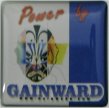|
 Gainward 750Ultra/XP Golden Sample (Geforce 4 Ti4600) Gainward 750Ultra/XP Golden Sample (Geforce 4 Ti4600)
Posted: August 7th, 2002
Written by: Justin "The Sheriff" Woods
System Specs and Benchmarking
System Specs:- AMD Athlon @ 1.4 Ghz
- 768 Megs PC 2100 DDR
- MSI KT266 Pro R
- Hercules Game Theatre XP
- 2 IBM 40 Gig drives striped (RAID 0)
- AGP Fast Writes Enabled in BIOS
|
More...- Windows 2000 SP2
- 19" Viewsonic G90f (perfect flat)
- Nvidia Detonators Version 29.42
- Dungeon Siege Benchmark Tool
- 3D Mark 2001 se
- Q3Bench 2.0
|
| A note about drivers: Gainward offers two versions of drivers on the CD. One labeled "Faster", and one labeled "WHQL". Though I didn't install the drivers, rather opting to use Nvidia's Detonators, I thought it might be good to throw that in there if you decide not to download the newest Detonators from their site. Also Included on the CD is an overclocking tool called EXPERTool. I think it's pretty cool for them to include a built in tool for overclocking your card, it also shows a lot of confidence in their product. That is a good sign. Up first we have the well known 3D Mark 2001 which can be downloaded here for free. As you read this there is a new version, (build 330). I used build 300, which at the time was the most recent. The version of 3D mark 2001 I used runs a battery of 17 tests, which cover everything from bump mapping to advanced Pixel Shading. Oh, by the way, if any of the terms here seem unfamiliar to you , you can always look at our 3D lingo glossary here. |
1280x1024x32 @ 85 htz
 |
| Sporting respectful numbers in all version of AA (Anti-Aliasing), the Ti4600 is extremely consistent, as you will see in some of the upcoming results. The difference between Quincuxx ™ and 4x, is usually about 1500 3D marks. Similarly, the difference between 4x and 4xs is usually only about 150 3D marks, though 4xs gives you far superior image quality. I did some research to get a ballpark for what I should be seeing as I benchmark this card, and I was surprised to find that Nvidia's own documentation for this exact test was only about 65 3d marks lower, and that was running on a P4 @ 2ghz, 128 MB memory, Win XP, and the same resolution. This could be attributed to their tests being performed on an older version of the detonators, XP, or a combination of the two. Pay special attention to the bottom graph as the only difference is the monitor refresh rate. I wanted to see if there was a significant difference between 85htz and 75htz. I think the answer is in the number. My opinion: Crank it up to 85htz for absolutely flicker-free fraggin'! |
1280x1024x32 @ 75 htz
 |
|